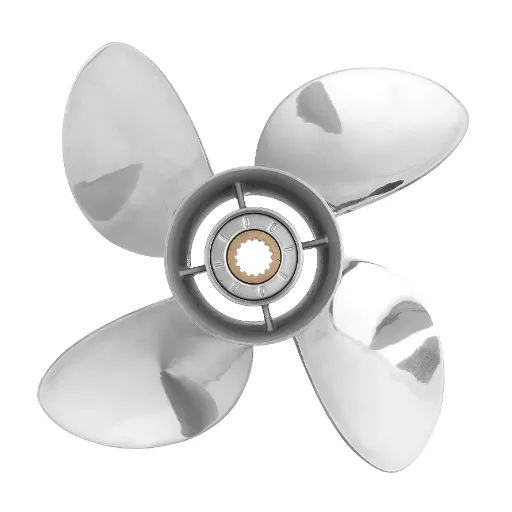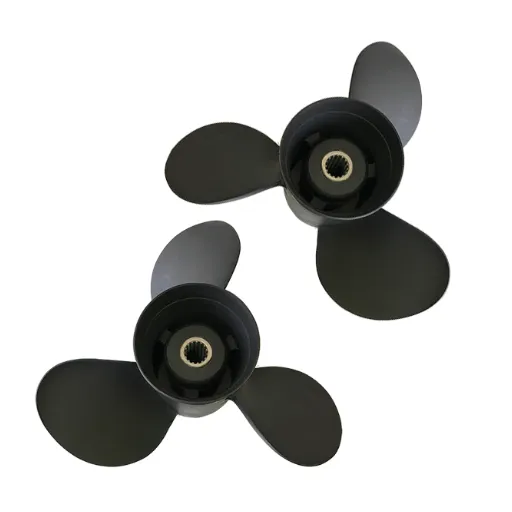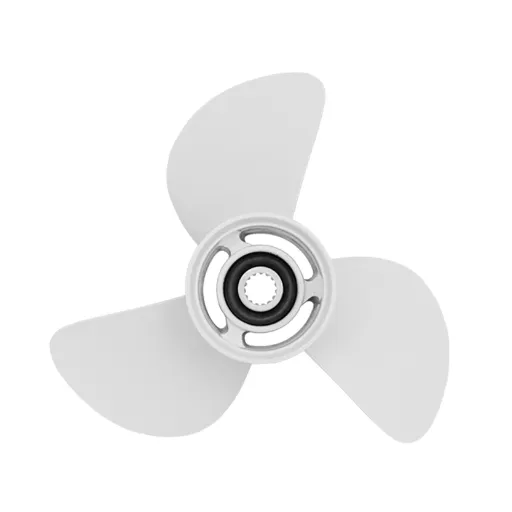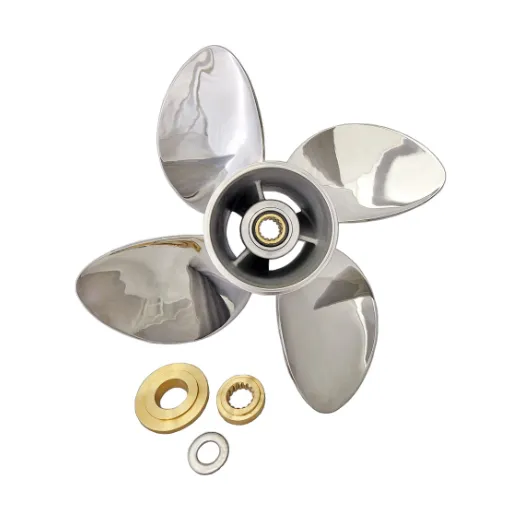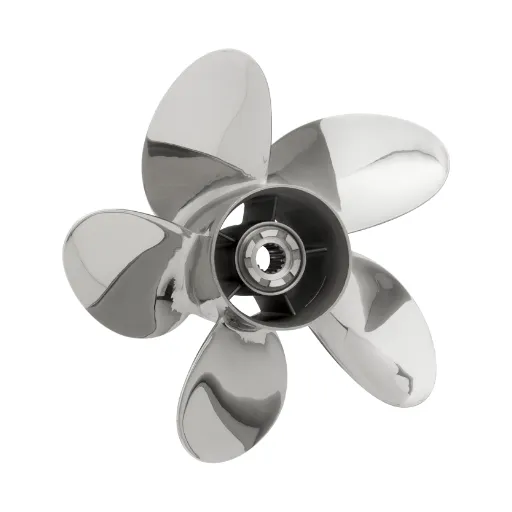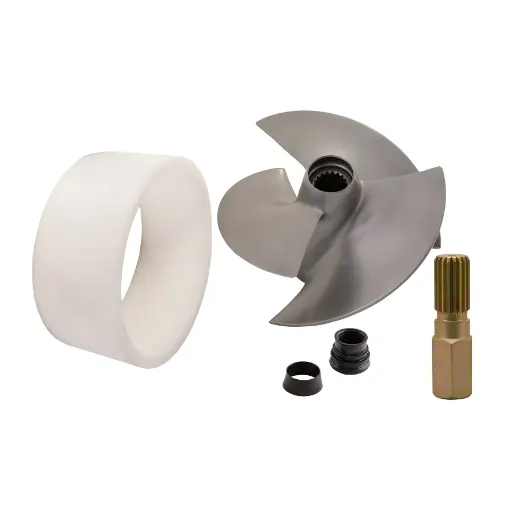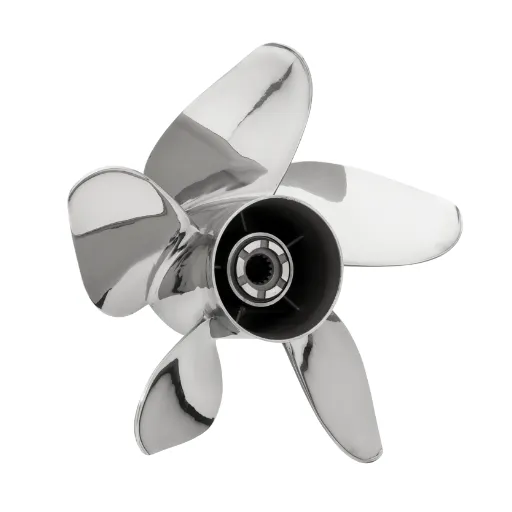Since the advent of motorized boats, the propelling system has been their lifeline and the central theme for marine innovation. Approaching 2025, major breakthroughs are littering both outboard and inboard propulsion technologies, carving new paths in performance, efficiency, and green alternatives. The boat propeller world is an evolving rapid pace, gaining new materials, making new designs considerate of ecological pressures, and winners for speed. This article will discuss new innovations and trends that are shaping the future of propeller technology, thus helping to cast some light to boat enthusiasts, engineers, and marine industry professionals. So if you’re a boating enthusiast or just curious about the future of marine engineering, buckle up for a thrilling tour.
Advancements in Propeller Technology
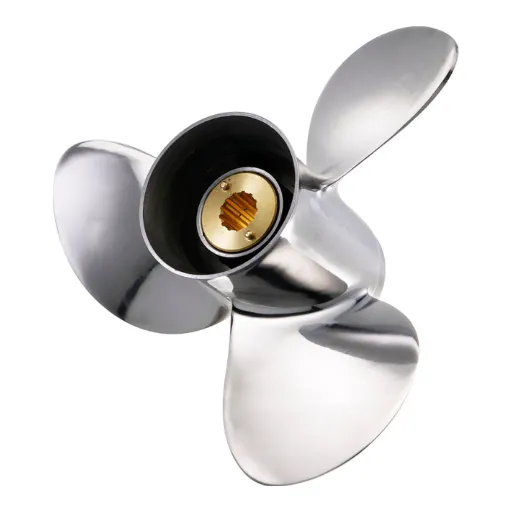
Sharrow Propeller Innovations
Sharrow Propeller technology is a true paradigm shift in marine propulsion, offering substantial advancements in efficiency and operational performance. Whereas conventional propellers possess blades fixed on a hub, Sharrow Propellers instead utilize a somewhat looped blade design that generates less drag and turbulence in the water. This different form provides for more orderly motion of water, reducing energy losses, and decreasing fuel consumption-a consideration of utmost importance to both recreational boaters and commercial-based vessels.
Key Benefits of Sharrow Propellers:
- Up to 20% reduction in fuel consumption
- Minimized vibrations for comfortable boating
- Enhanced durability with high-quality materials
- Versatility across different boat types
Fuel economy is a crucial advantage imparted by Sharrow Propellers. Various tests and studies have shown that boats equipped with Sharrow Propellers can go up to 20% less fuel than those with standard propellers. This incentive makes Sharrow Propellers an attractive option for any wanting to embrace eco-friendly technology while simultaneously saving on operational costs. Additionally, with vibrations being kept to a minimum by the high-tech design, a more pleasant and quietly comfortable boating experience is guaranteed, which brings great appeal to luxury and leisure marine segments.
Sharrow Marine, innovator of these propulsors, has focused on their toughness and versatility. The Sharrow-style propellers are manufactured from materials of the highest quality to cope with the corrosive nature of the marine environment, guaranteeing longer reliability. These propellers may even be adapted to different types of boats, from speedboats to fishing boats. Being a technology under continuous development and upgrade, Sharrow Propeller technology is setting new benchmarks in marine propulsion, envisioning a tomorrow where performance, efficiency, and sustainability coexist.
Electric Propulsion Compatibility
With full compatibility with electric propulsion systems, Sharrow Propeller technology may be touted as an alternative towards sustainable and efficient marine transport. This capacity allows the synergy to be maximized between an advanced design of Sharrow Propellers and the unique nature of electric motors, i.e., high torque at low speeds and smooth operation. This results in better performance at low-energy usage-a perfect recipe for eco-boating.
The propeller reduces drag and increases thrust over a range of speeds; this coupled with an electric propulsion system makes an efficient propulsion system that increases battery life and range, thus making it very attractive for anyone interested in a reliable and sustainable marine drivetrain. Noise and vibration are further reduced, thus providing a very pleasant experience on the water.
With an ever-expanding innovative edge, Sharrow propellers iterate with propulsion technology. Compatibility with electric propulsion systems speaks volumes as to the possibilities opened up by Sharrow Propellers’ versatility and cutting-edge design to be the preferred candidate for enhancing the performance of modern vessels with an environmental conscience. Where Sharrow Propellers and electric propulsion converge is an important step toward the greener future of marine travel-encompassing all pleasure users and commercial operators.
Anti-Fouling Coating Developments
In Anti-fouling coatings put the spotlight on vessel efficiency and on reducing environmental impact. On account of the disturbance with large organisms resulting from marine organisms on hulls, traditional anti-fouling coatings employed poisonous substances as biocides. Now the technologies are heading toward greener options-a paradigm shift in the scenario. One important development is the silicone foul-release system, which provides smooth surfaces with low friction for preventing organism attachment instead of releasing toxic chemicals to contaminate the waters.
Moreover, nanotechnology is being developed to produce imparting superior toughness to the coatings with enhanced foul resistance as well. These coatings catalyze the disruption of biofilm buildup by introducing nanostructured materials and discourage the adherence of barnacles, algae, and other organisms to the surfaces. Such developments intend to lessen maintenance costs and fuel consumption through enhancement of hydrodynamic performance.
The other trend worthy of note is the utilization of bio-inspired solutions. Coatings that are designed to mimic naturally evolved and employed antifouling marginally by marine life, for instance, shark skin textures, offer an ecological alternative to chemical antifouling. These initiatives are in line with the worldwide conventions that seek to curb marine pollution, thus showing the maritime industry’s willingness to ensure a balance between efficiency and ecology.
Materials and Design Trends
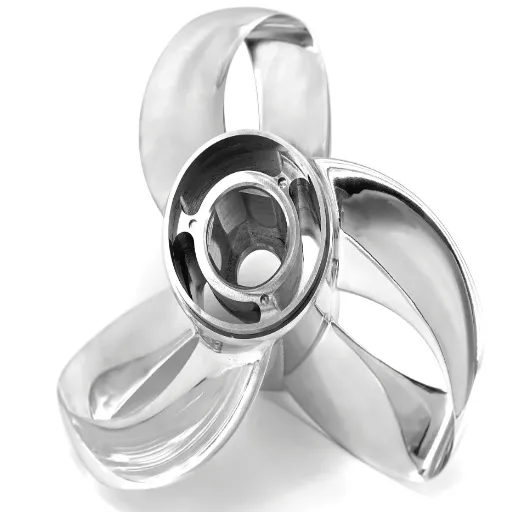
Aluminum vs. Composite Propellers
Aluminum propellers are less expensive, durable, and heavier, but composite propellers are lightweight, efficient, costly, and offer better performance with lesser vibrations.
| Aspect | Aluminum | Composite |
|---|---|---|
| Price | Affordable | Expensive |
| Mass | Heavy | Lightweight |
| Strength | Durable, corrodes | Tough, corrosion-free |
| Efficiency | Standard | Superior |
| Vibrations | More | Less |
| Upkeep | Frequent, material loss | Rare, material replace |
| Longevity | Limited | Unlimited |
| Sound | Noisier | Quieter |
| Design | Simple | Sleek |
Foldable Design for Enhanced Performance
Off-the-wall designs have redefined the term “modern products,” allowing an ideal mix of portability and use. For example, folding innovations provide compact solutions in systems ranging from technology to transportation without letting performance float away. The designs such as foldable phones have been gaining popularity due to their growing facility to sit in between being truly mobile and being large-screen-ready application from a customer perspective for that very flexibility. Thus, foldable bikes and scooters aid urban commuters in space reduction without compromising on strength and efficiency required for daily utility.
An advantage-foldable design concerning space would be the preservation of durability. Such designs are generally constructed using advance materials like composites because of light weight and high strength estimates. Compared to conventional materials such as aluminum, composites improve wear resistance of foldable structures while also offering them with an ultramodern look. For instance, a composite frame gives a foldable electric bike advantages in terms of vibration reduction while maintaining a lightweight build that enhances comfort and quietness during rides. Such features make foldable products an ideal solution for individuals and companies that need a product that is both efficient and portable.
Not only do foldable design solutions help toward promoting sustainability, but they actively contribute toward it in diverse ways. Their use of durable materials, repairable and modular components builds extended use for foldables, thus less waste. On the other hand, compactness impresses either the shipping or storage logistics and in the end reduces the carbon footprints. Be it a foldable solar panel for off-the-grid energy needs or foldable furniture for space optimization, this design approach is increasingly changing industries and redefining consumer expectations all over the world. The possibilities offered by foldable designs, with innovation and advanced materials backing them, are many and growing in chauffeured necessity in the present times.
Impact of Weight on Propeller Efficiency
Anything with a greater weight causes quite a lot of effects on the plane propellers in particular thrust requirements, fuel consumption, and performance. The heavier the aircraft, propellers demand great power to lift and propel, consequently decreasing their efficiency and wearing down the components. Understanding such influences is key to propeller performance optimization. The points below summarize major facts concerning the influence of weight on propeller efficiency:
- Thrust Requirements: The higher the weight, the greater the load on the propellers in providing enough thrust to counteract the force of gravity. Thrust load reduction of worst propeller efficiency.
- Power Consumption: More cumbersome the load, more engine power it demands, thereby expending more units of energy per unit of distance traveled. And overtime, this will badly affect the fuel efficiency and hike operational costs.
- Blade Aerodynamic Performance: An increase in weight may result in the propeller blades being subjected to elevated levels of stress that may over time reduce their aerodynamic efficiency and effectiveness.
- Takeoff Performance: Weight affects take-off runs and climb rates directly. Longer runways and higher thrust from the propellers are required during this critical phase for heavier aircraft.
- Structural Load on Propeller Components: Light weights act on propeller components to cause protracted wear, with concurrent frequency in the maintenance and replacement of parts.
When managed well in this way concerning aircraft weight balance along with propeller design and efficiency requirements, operators stand to enjoy better performance and lower cost over time.
Market Trends Shaping the Propeller Industry
Emerging Popular Models for 2025
Innovation is thriving in the propeller business as manufacturers respond to changes in materials, aerodynamics, and green concerns. Now, some models are acquiring attention in 2025 due to their starkly cutting-edge design and improvements in efficiency. Composite propellers-no pun intended-light-weight materials bound with high durability to deliver propellers-were being asked for by commercial and general aviation industries alike. Reduced fuel-use, low operational noise, and longer service life all go in the direction of meet-and-greet sustainability demands.
Electric propulsion systems are keeping a step ahead of propeller development towards hybrid and electric aircraft. Performance optimization at comparatively lower speed is the main aim of these propellers which have advanced blade geometry to obtain this goal maximally. Another style being offered is modular propeller system in order to solve many aircraft applications through quick customizations and fast replacement of components by using standard interchange.
As UAVs become hot topics, small sized specialized propellers for unmanned activities are gaining fast momentum. They complement strengthened maneuverability, power efficiency, and noise abatement, thus making these propellers highly sought-after for drone commercial applications, including delivery services, aerial mapping, and reconnaissance.
Weaving together contemporary demands with technological breakthroughs, they are paving the path for a new in propellers that stands for performance, sustainability, and adaptability.
Role of Major Brands: Mercury and Volvo Penta
Mercury Marine
Mercury has developed reputation and marketing for operating advanced propeller designs in recreational, commercial, and military applications. Mercury uses advanced materials and engineering techniques emphasizing sturdiness, performance, and fuel economy and thus being the favorite for high-performance watercraft and UAV applications.
Volvo Penta
On the other side, Volvo Penta focuses on sustainability and changes with its philosophy. They are known to manufacture eco-friendly technologies where the world tries to reduce environmental impacts while treating their concerns toward performance. From small marine vessels to specialized marine crafts, their products assure reliability and adaptability in application.
These two brands lay emphasis on the advancement of propeller technology, creating solutions that speak of a balance among power, efficiency, and environmental consciousness in a running market.
Performance and Efficiency Enhancements
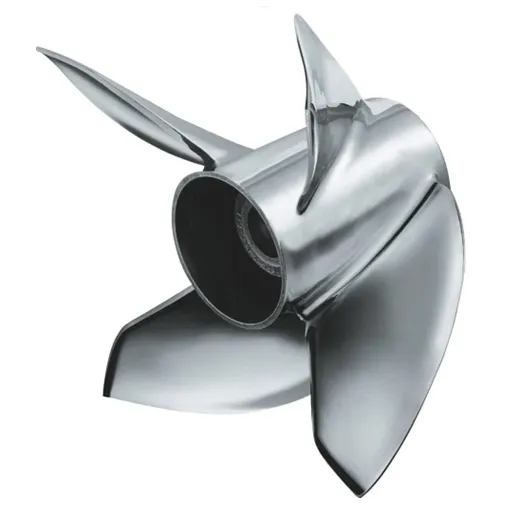
Best Practices for Propeller Selection
In the marine industry, selecting the right type of propeller is one of the critical factors for performance, efficiency, and longevity. Here are some best practices for selecting the propeller for a particular marine vessel:
- {step-counter}
Understand Vessel Requirements:The type of vessel and its intended use-whether for speeding, heavy-load transportation, or recreational applications-plays a major role in propeller selection. Designed hulls, engine power, and environment of operation go into a thorough assessment of making a propeller choice. - 2
Analyze the Specimen of a Propeller:Basic elements such as diameter, pitch, number of blades, and material composition influence the propeller performance. In general, larger diameters provide increased thrust, while the pitch of the blades determines the distance traveled per revolution. Both must correlate with the engine capacity of the vessel and the load to be applied on it. - 3
Focus on Engine Compatibility:Make sure that the chosen propeller corresponds with the RPM range recommended for the engine. Running the engine either above or below the recommended RPM leads to engine inefficiency, increased fuel consumption, or its timely deterioration. Finally, refer to the guidelines of the manufacturer. - 4
Consider Environmental Impact:The water conditions, whether it be freshwater or saltwater, as well as the operating depths, all affect propeller functionality. For instance, stainless steel is good against corrosion due to saltwater even though it stays hard for a prolonged period. For ships which operate more in shallow waters, the choice of propeller would favor minimize damages. - 5
Evaluate the Technical Development:Modern propellers usually incorporate advanced features such as variable pitches or energy-saving blade designs that, besides providing better performance, conserve fuel and thus protect the environment in favor of sustainability. - 6
Testing and Maintenance:For the best effect, the propeller should be regularly tested for efficiency and be inspected for any signs of wear and tear. Early isolation of problems, such as cracks, bending, etc., will help towards maintaining optimal operation and avoid expensive repairs or replacement.
Adhering to these best practices would result in the vessel operators enjoying a continuously reliable performance environment combined with reduced operational cost and consequently a longer life span for both the vessel and the propeller. In case of further precision in respect to methodology, the decision process could be eased much by consulting a marine expert or considering advanced selection tools.
Impact of Prop Design on Wake and Handling
Wake production and handling attain significance because of a propeller’s design. Understanding the effects of design and its influence on performance allows the operator to optimize vessels for specific applications or conditions. The five main prop design factors and their respective effects are as follows:
Number of Blades
More blades mean less cavitation and better balance, and therefore, better vessel handling. But more blades mean more drag and slight loss in efficiency.
Blade Pitch
Higher pitch means more thrust at high speeds, benefiting fast vessels in their handling. Conversely, a low pitch is best for maneuvering at low speeds in confined spaces or during docking.
Diameter
Higher diameter means more thrust, capable of stabilizing the wake and providing smooth handling in rougher conditions, whereas adjustments may be required for the engine and drivetrain in order to accept the upgrade.
Skew Angle
A high skew angle allows reduction of vibration and noise, thus permitting fluid handling and controlled wake. This is important in passenger vessels where comfort is paramount.
Hub Design
Different types of hub design, such as streamlined or flared, affect water flow and wake quality. When well designed, the hub reduces turbulence and hence allows increased control of the vessel, especially while turning sharply.
Each of the above factors represents the intricate balancing act involved in prop design in order to ensure proper wake pattern and handling for different loads.
Evaluating Engine Compatibility with Prop Models
Engine compatibility has been determined by crucial determinations on whether a particular propeller is effective and efficient in doing so. Matching for performance: propeller design withigenic power output, gear ratio, and rotational speed ensures good performance under all operating conditions. Thus, large-diameter propellers with lower pitch values are favored in high-power-high-torque engines to maximize thrust and to avoid overloading the engine. On the other hand, lightweight, high-pitch propellers that impart reduced drag and enhancements to cruising efficiency are good for small power units.
This kind of compatibility assessment can further be refined by employing advanced analytical tools and with the aid of widely accepted actual performance data. Rage of modeling techniques presents an evaluation of different engine-propeller combinations under various load conditions, giving indications concerning RPM efficiency, fuel economy, and high vibrations. Adjustable propellers and interchangeable hub design, moreover, provide the operator with extensive options to fully optimize performance to the application.
Following a thorough systematic analysis of engine compatibility allows for an optimum match, which improves thrust, fuel economy, and durability while limiting the overall wear and tear on the drivetrain.
Sustainability in Boat Propeller Production
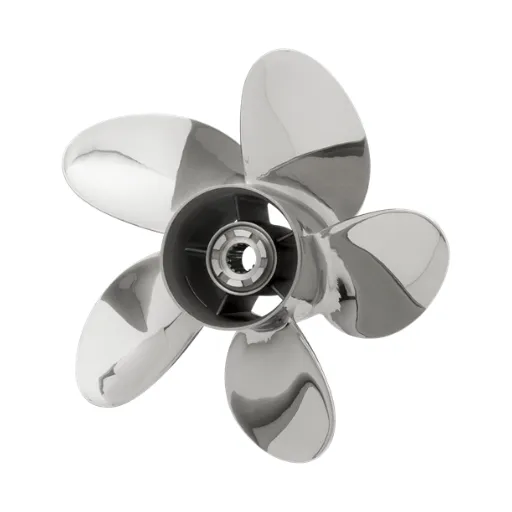
Eco-Friendly Materials and Manufacturing Processes
When considering eco-friendly materials, I tend to be more heavily inclined towards using alternatives that lessen the impact on the environment while still performing adequately. Recyclable aluminum and composite materials provide very recent alternatives that can be used in making boat propellers. The casting of such materials reduces waste and their application in constructions is design-oriented for durability and efficient operations equivalent to conventional designs of propellers. Using these kinds of materials is a way of reducing the carbon footprint of our industry.
The manufacturing processes to be employed are equally critical. I ensure that methods adopted emphasize energy efficiency and waste reduction. Propeller manufacture has been revolutionized by such techniques as investment casting and 3D printing, which allow us to utilize materials more efficiently and with less energy consumption. And when facilities run on solar and wind power, their footprint shrinks even further.
Finally, I like to encourage companies and suppliers that consider sustainability as one of their core values. Creating a cycle of eco-conscious innovation and collaboration will pave the road toward green developments in marine technology and support us to fulfill our responsibility towards nature. There is a conscious attempt to balance performance, efficiency, and the wellness of our planet.
Recycling and Lifecycle Considerations
Recycling plays a crucial role in waste reduction and resource conservation, particularly in industries reliant on materials such as metals, plastics, and composites. Reclaiming aluminum and steel means manufacturers send less demand for virgin materials, save energy, and reduce greenhouse gas emissions. Aluminum recycling, for example, takes 5% of the energy as that for producing it from raw ore. Likewise, plastics can be vacuumed from disassembled products to be melted and remolded into new parts, allowing for considerable reduction of landfill and resource extraction.
Another key idea behind sustainability is to consider the product from a lifecycle perspective. LCA enables companies to evaluate the environmental impact of their projects from the cradle to the grave. Research has found that the longer the lifespan of a product and the easier it is to disassemble, the more companies can reduce material consumption and waste. For instance, modular marine components allowing easy maintenance, upgrades, and recycling are quickly gaining legitimacy. The increased efficiency through this approach synergistically enhances the circular economy, where materials are valued and continuously reused and repurposed instead of being cast to one side.
The evolution of recycling methods and resource recovery further fortify the upward trajectory of sustainable practices. Chemical recycling, for instance, can convert plastic waste back into its base chemicals, which can be processed further into new plastics of the same quality. Another evolution in waste sorting and AI-based systems will ensure recycling processes operate much more efficiently so that fewer materials are lost. Industries can therefore considerably reduce their environmental footprint and cultivate innovation toward production sustainability by uniting these evolutions with a strong circular economy mindset.
References
-
MIT DSpace: Design of a propeller for a human-powered boat – A detailed academic study on propeller design for boats.
-
Academia.edu: A study of boat and boat propeller-related injuries in the United States, 1991-1992 – Research on injuries caused by boat propellers, providing statistical insights.
-
Oregon State University Library: Power performance of planing boats with the effect of propeller selection and propeller guard design – A study on how propeller selection impacts boat performance.
-
MIT DSpace: Design and construction of a high-speed human-powered boat – Focuses on the construction and design of high-speed boats, including propeller considerations.
-
Academia.edu: Design of Propeller Powered Vehicle – Discusses propeller testing and thrust calculations for vehicles, including boats.
Frequently Asked Questions (FAQ)
Q: What is a boat propeller? How does it work?
A: Essentially, a boat propeller is a mechanical device that converts rotational energy into a thrust that carries the boat through water. Usually, it consists of blades that rotate 360 degrees around a central hub. While in motion, the blades push water backwards, basically pushing forward the boat. Performance-wise, material-wise, planking-wise (stainless steel propeller vs. aluminum, for instance) has a considerable effect on performance and efficiency in action and durability.
Q: How should I go about selecting my outboard propeller?
A: In choosing the right outboard propeller, one has to consider the horsepower of the boat, weight, and the use it is intended for. Thus, pitch, diameter of the prop, and number of blades could affect the performance, where there are super stainless steel propellers that may give more performance and speed than aluminum ones. Thus, one could consult expert or go to a shop that deals with boat propellers for the best insight.
Q: Why would I want to use stainless steel propellers?
A: A stainless steel propeller is a better choice for the purpose of maintaining top speed and hill shots. A stainless steel propeller is sturdier and stronger and lasts much longer than an aluminum propeller. Compared to aluminum, it is made resistant to corrosion. High-performance propeller manufacturers like Solas and Michigan Wheel make top-quality stainless steel propellers for a wide variety of applications to best fit your outboard.
Q: How do I improve the hole shot of my boat with the right propeller?
A: The hole shot is the time taken by a boat to accelerate from a standstill condition to a planing speed. Improve your boat’s hole shot with a propeller that has a lower pitch.
Q: Why is pitch important in a boat propeller?
A: The pitch is the critical angle of the blades on the propeller and as decided by this angle, will determine how far the boat travels irrespective of each rotation of the propeller. A higher pitch guarantees greater speed at the expense of low acceleration while the lower pitch assures better acceleration at the expense of top speed. To understand pitch would mean understanding what pitching will do for your boating needs in cruising or water sports.
Q: How to install a new boat propeller?
A: Installation of a new propeller can be pretty straightforward. With the outboard switched off and secured, remove the old propeller by taking off the retaining nut and washer, then sliding the propeller off the shaft. Place the new prop-fitter insert so that it sits correctly on the shaft in a snug fit. Follow with the washer and nut, tightening them securely. Always refer to your owner’s manual for installation instructions to avoid damaging your prop.
Q: How do I maintain my boat propeller?
A: Fishboat propellers need every bit of maintenance to give optimal service for a long time. Inspect the prop for dents or corrosion, especially after hitting debris along the way. Clean the prop often to get rid of any marine growth or debris. Also, lubricate the prop shaft and check the propeller’s alignment to prevent vibration wear during operation: these will keep your prop running well.
Conclusion
The marine propeller industry is experiencing unprecedented innovation as we approach 2025, with revolutionary technologies like Sharrow Propellers leading the charge toward more efficient, sustainable, and high-performing marine propulsion systems. From advanced materials and eco-friendly manufacturing processes to electric compatibility and smart design considerations, the future of boat propellers promises enhanced performance while maintaining environmental responsibility. Whether you’re a recreational boater or commercial operator, staying informed about these technological advances will help you make better decisions for optimal vessel performance and sustainability.




